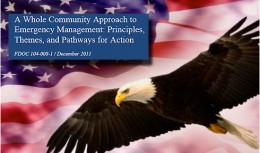 Hurricane Sandy brought out the best in many people, the worst in a few, and brought intense stress to the entire communities of Wyckoff, Franklin Lakes, and at least half of Oakland.
Hurricane Sandy brought out the best in many people, the worst in a few, and brought intense stress to the entire communities of Wyckoff, Franklin Lakes, and at least half of Oakland.
Property destruction was dwarfed by the widespread power outages that blanketed the area, leaving thousands of residents huddling in darkened homes with temperatures plummeting.
Those who could left, and those who stayed struggled with staying warm, lining up for gasoline in the face of massive shortages, and seeking information as to when hope would arrive.
With the vast majority of residents back on the grid, with electricity flowing, televisions glowing, and computers once again connected, it’s a time to be thankful for the tremendous efforts put forth by officials, local borough employees, houses of worship, and other nongovernmental organizations.
It’s also a time to consider how prepared towns like Franklin Lakes, Oakland and Wyckoff are when it comes to how the communities prepare for disasters.
A FEMA report published in December 2011 and entitled A Whole Community Approach to Emergency Management, provides a framework for developing an emergency response plan for a community – and the FLOW region responded in that fashion more by instinct rather than design.
Organizations, businesses, private citizens, and houses of worship mobilized to help where and when they could which was critical in mitigating the suffering and damage.
According to the FEMA report, “As a concept, Whole Community is a means by which residents, emergency management practitioners, organizational and community leaders, and government officials can collectively understand and assess the needs of their respective communities and determine the best ways to organize and strengthen their assets, capacities, and interests.”
These nongovernmental organizations are more flexible and adaptive when needing to respond; and many were able to take immediate action during the recent disaster. In the aftermath of Hurricane Sandy, there is an opportunity to formalize and improve on that social network structure that became so important when our infrastructure failed.
Chambers of commerce, nonprofit organizations, hardware stores, supermarkets, media outlets, school boards, faith-based organizations, community leaders, and individual citizens are just some of the entities FEMA suggests be engaged when planning for a whole community response to a disaster situation.
Recognizing that government cannot manage disasters alone means communities need utilize their full potential in times of a disaster. Residents of the FLOW communities did this by identifying priorities, organizing support, implementing programs, and providing a whole community response to an unprecedented situation.
The Sandy Hurricane has now set a precedent, and formalizing a whole community response plan may be how communities plan for future disasters.
Links:
FEMA Whole Community December 2011 Report PDF
FEMA: Whole Community Idea Bank
http://fema.ideascale.com/a/ideafactory.do?discussionID=58329
FEMA Whole Community Outline
http://www.fema.gov/whole-community
